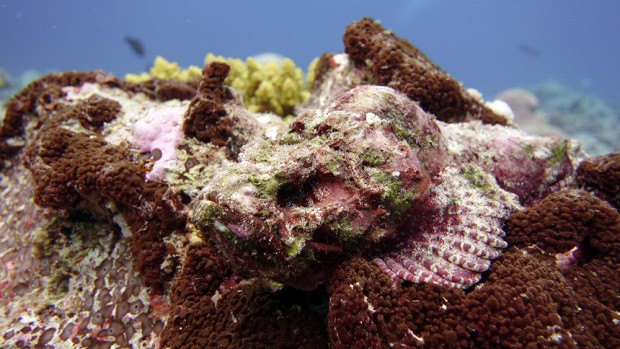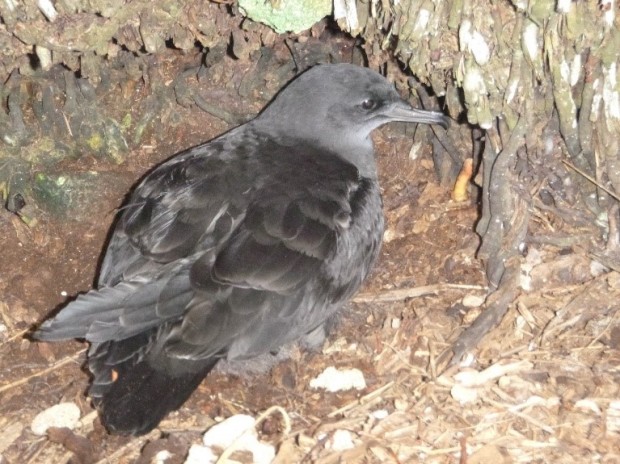2015 Darwin Science Expedition - Day 19 Scorpionfish and shearwaters

This morning activity centred around the island of Middle Brother on the western Great Chagos Bank. It is one of the most scenic islands in the territory and proved to be equally appealing beneath the surface.
Nick and Shaun headed ashore this morning to conduct their work on the island and in the beautiful lagoon there. The remainder of us headed to dive off the north western edge of the island. Here the routine of surveys went ahead while I managed to get some great shots of a colourful Elizabeth’s Chromodoris – a nudibranch with bright orange trim.

The most engaging encounter of the day though was undoubtedly seeing a group of large coral trout hunting with a morey eel. The grouper signal their co-operation with the morey by shimmying their bodies and changing colour (as can be seen in the video clip below). The morey responds to the signal by foraging in the crevices and beneath corals that the grouper can not reach, flushing out prey which the grouper then attack in the open to the mutual benefit of both. Chris watched this for about 10 minutes on his safety stop at the end of his dive telling me as he came out the water. I quickly jumped in and got this footage before the behaviour stopped a few minutes later.
VIDEO https://www.youtube.com/watch?v=SSYSd5AnwHc
Another lovely behaviour seen on this dive was a school of fusilier stopping at a cleaning station, all taking turns to present themselves to the cleaner wrasse who feed on dirt and parasites of their visitors to keep them healthy.
VIDEO https://www.youtube.com/watch?v=nf0FbTKuy8k
The shore party had a busy day making the most of calm conditions to visit North Brother, Resurgent Island and Middle Brother.

This evening for me it is on to South Brother with Pete to continue Coconut Crab surveys. While I head ashore I'll leave you with some words from Pete on terrestrial activity to this point.
The islands of the Great Chagos Bank
Dawn on the fourth of April 2015 saw the ship anchored just south of Nelson’s Island. This was to be one of the big seabird days of the trip for me and counts start as soon as there is light enough to see birds. This island is fairly unique in the Chagos. It is isolated on the northern rim of the Great Chagos Bank. It was never inhabited and has not been farmed for coconuts. Probably due to its isolation and lack of man’s influence, there are less plant species present than on most other islands. What vegetation is present is sculpted by the salty winds. It is a mecca for breeding and roosting seabirds.

Before first light I was on the bridge wing of the ship looking and listening for birds. As my eyes adjusted to the cloaked grey of dawn I started to see streams of noddies leaving the northwest corner of the island for their days feeding and foraging. As the light grew better I was able to count the number of birds leaving the island per minute. We were lucky in that a south-westerly was blowing at dawn and most of the birds leaving the island were coming off the island near where the ship was anchored. Two hundred birds per minute as darkness crept in to twilight, 500 birds per minute as daylight broke. As the sun started to rise the frigatebirds and boobies started to leave the island. Frigatebirds soaring high before heading out to sea, spearheads of Red-footed Booby shearing the waves as they departed and, smoky lines of noddies constantly wisping their way to sea. It was an incredible sight and a challenge to try and assess the numbers. For the record, some 20,000 seabirds roosted on the island and headed out to sea in the first light of the day. It was now time for breakfast before heading on to the island to count the breeding birds.

The visit to Nelson’s Island was successful and despite the difficulties of conducting a breeding seabird census on this island where unlike most of the other islands, the birds nest in the interior as well as the shoreline, figures were extrapolated from plot counts to arrive at overall totals. Despite what the dawn exodus indicated, noddies were not breeding in any spectacular numbers, emphasising the importance of some of the islands as nocturnal roosts as well as breeding sites.
As the divers returned from their underwater forays the ship weighed anchor and we headed west in to the setting sun. As we sailed away from Nelson’s Island, stringy lines of noddies were returning from their days feeding activities. The daily avian cycle of the island was coming to a close. In amongst the returning noddies flashed the occasional stiff-winged black and white Tropical Shearwater. These were to become the focus of the next two days research at the islands on the western rim of the Great Chagos Bank, starting with the Three Brothers.
The Three Brothers actually are four islands. Three of these are vegetated and one, Resurgent, is a barren, wave-washed upraised rock similar to Coin du Mire in Peros Banhos. Similar to its counterpart in Peros Banhos, it is home to a colony of Masked Booby and these were present in the highest numbers I had witnessed ever. Gaining land on Resurgent is always adventurous but as the seas were relatively calm I swam ashore and scaled the rocky side to take a closer look at the plateau where the boobies breed. Similar to previous visits, the boobies were at all stages of breeding from displaying pairs to recently fledged chicks. Another salutary reminder that coming to any conclusions about breeding population fluctuations based upon a single snapshot is unsound.
North Brother was our next island. A wonderful seabird island but troublesome to swim on to due to its conflicting currents and rocky beaches. The swim ashore is generally made on to a 10m wide sandy beach enclosed by rocky walls. This should present no great problems but, this beach is also where three different currents meet and produce some “Phantasia-type” waves that both overhaul swimmers (particularly when swimming with equipment) and throw them off course. Fortunately our swim in was uneventful.

North Brother holds the greatest number of breeding shearwaters in the entire archipelago and the island is honeycombed by their burrows. Counting nesting birds that are deep in burrows presents challenges to the researcher. First there is the question of occupancy. This can usually be ascertained through a combination of indicators such as feathers around the burrow, signs on the ground of birds shuffling in and out, the occasional bird being visible in the burrow and the smell! Breeding shearwaters (and petrels) have a glorious, distinctive odour that comes from the oil they secrete and preen and waterproof their feathers with. Once smelt never forgotten and possibly mildly addictive! So, much to the amusement of Claudia who had accompanied me, I was regularly poking my head in to burrows and having a good sniff around. (Some photographs do exist of this activity but are not thought to be complimentary to the researcher or the good name of science!).
The second problem is which species present? This proved to be the surprise of the trip for me. Previous surveys have always assessed Wedge-tailed Shearwaters to be far more numerous than the smaller Tropical Shearwater, normally at something like a 4:1 ratio. The studies I made throughout the day on both North and South Brother held true to this ratio, finding about four Wedge-tails to every Tropical. However, when Jon Schlayer and I camped overnight on South Brother to conduct further Coconut Crab surveys, Tropical Shearwater by far outnumbered Wedge-tails. As darkness closed upon the island the eerie Nazgul-like wailing of Tropical Shearwater was heard all around and birds were seemingly dropping out of the sky in to the natural coconut forest and even in the grassy open areas and scuttling off in to burrows. Very difficult to produce a credible, scientifically calculated total of breeding birds but certainly, there are far more Tropical Shearwaters breeding on South Brother (and I suspect North) than I ever envisioned. In fact, I would go further and say, at least this year on South Brother, there are more Tropicals’ breeding than Wedge-tailed. I suspect that this may be the case in most years and that Tropical Shearwater being smaller, is simply harder to locate when searching burrows in the daytime. Tropical Shearwater also produced another conundrum for me and this teaser was, “what is the true taxonomic status of the Chagos breeding population?”
Briefly, there has recently been a taxonomic shuffle of the Little and Audubon’s Shearwater complex. These two species have been split in to several new species and in the Chagos we have ended up with Tropical Shearwater Puffinus bailloni subspecies dichrous. Included in this subspecies are three former subspecies one being named nicolae, which was suggested in Peter Harrison’s ground breaking Seabirds book to be the species present in the Chagos. In recent literature, dichrous is given a breeding distribution that encompasses island groups are far apart as Tahiti and Aldabra. However, and here is my point, the illustrations I have seen of the diagnostic underwing pattern of subspecies dichrous do not match any of the Chagos birds I have handled or photographed in flight. With limited literature on board this mystery will have to remain as such until I return to dry land and a more extensive reference library but, I am keen to see illustrations or specimens of dichrous……..

And so, the final islands of the Great Chagos Bank were surveyed. Eagle Island, the second largest island in the archipelago remains a rat-infested, barren, bird-free island; Cow remains relatively unspoilt, probably because it is a “cow” to swim on to and finally, Danger Island lived up to its name and produced the most challenging swim on due to under currants and rip tides. The reward on Danger were over a hundred pairs of Brown Booby sitting tight on their recently laid two eggs.


